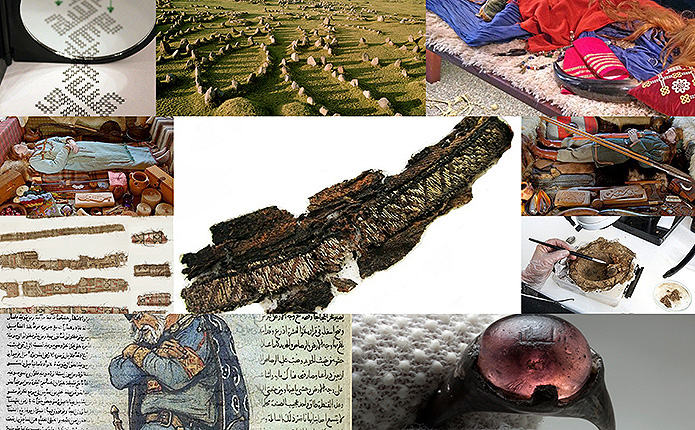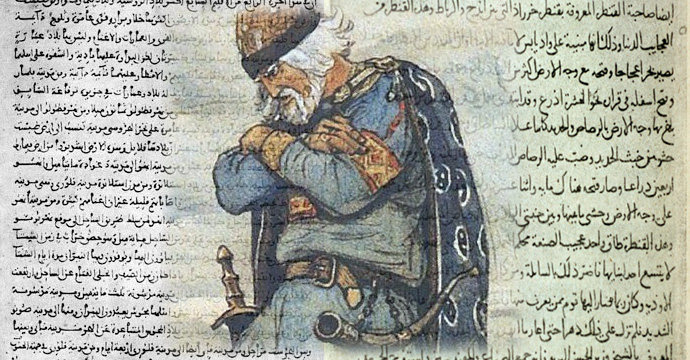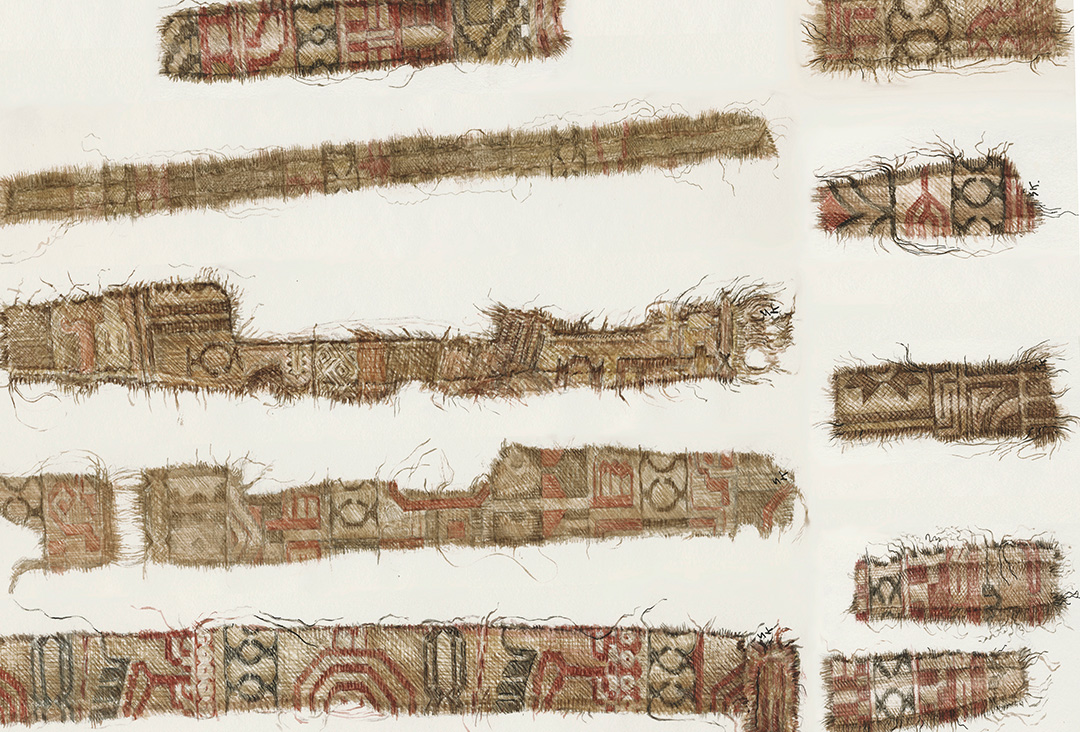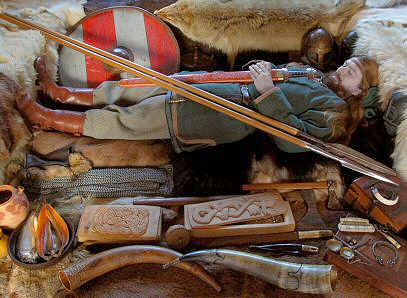As predicted in our previous article dating back to May 2015, additional studies and research have indeed revealed more artefacts illustrating European and Islamic Civilisation interconnectivity. Similar to the Viking woman who was found wearing an Islamic silver ring, it was recently revealed that Arabic characters on Viking burial garments have also been brought to light. This paper and the previous make the case that these discoveries indeed indicate the vast multicultural wealth which lies in overlooked places as it does in overlooked languages. What is more, the need to continue investing in research surrounding excavations such as the aforementioned to further demonstrate how interconnected civilisations such as the Viking and Muslim were.


Figure 1. Article Banner
![]()
![]()
Ahmed Ibn Fadlan, a 10th-century Arab traveler
  Figure 2. Enlarging the patterns and looking at the reflection in a mirror revealed the word ‘Allah’ (God) in Arabic (Source) |
After a discovery of Arabic characters on Viking burial garments went viral, the Viking woman who was found wearing an Islamic silver ring is hitting the headlines again. As stated and predicted in our previous article dating back to May 2015, additional studies and research revealed “more artefacts signifying European and Islamic Civilisation interconnectivity”[1]. Additional discoveries “indicate the vast multicultural wealth which lies in overlooked places as it does in overlooked languages.”[2]
The news of researchers in Sweden finding patterns woven with silk and silver thread spelling the words Allah and Ali[3] shocked readers and led them to question: “were Vikings Muslim?”[4] It is interesting to observe that these discoveries are receiving wider media attention. On the other hand, the discovery itself should not be received as surprising.
Trade, battles and many other interactions between Muslims and Vikings are reported to have been intertwined to such an extent that discovered artefacts from their day to day lifestyle – whether Vikings converted to Islam or not – should be perceived as commonplace. One wonders if they were indeed “kept in storage for more than 100 years, dismissed as typical examples of Viking Age funeral clothes”[5], what else may have been missed.


Figure 3. A museum display gives a sense of what the Viking woman’s boat grave in Gamla Uppsala may have looked like – similar to the tombs the fragments were found in. (Source)
Here are some highlights from our previous article[6]:


Figure 4. Pages from Ibn Fadhlan’s and al-Idrisi travel accounts about Rus/Vikings and a drawing of Oleg of Novgorod by Viktor Vasnetsov (Source)
Even though the discussion surrounding Vikings being Muslim appears to be controversial for some[15], there were already records Vikings converted to Islam long before this news came to light. Our previous article on this subject mentions “Muslim Vikings” where “a community of settled Vikings, who converted to Islam in southeast Seville, would be famous for supplying cheese to Cordoba and Seville.[16]” Another memoir states that sixteenth century Muslim geographer Amin Razi mentioned that: “…They [the Vikings] highly valued pork. Even those who had converted to Islam aspired to it and were very fond of pork.”[17]
Perhaps a more substantial question should have been ‘were those Vikings, whose burial clothes had Arabic inscriptions, Muslim?’ The answer being of course, why not… Islam was as prevalent at the time of the Vikings as it is today. An indicator of this is the impact of the transmission of Science from the East to the West during and prior to the Renaissance. In addition to science, there were also cultural influences, for example Europeans employing fashions such as carpets with the example of “England’s King Henry VIII (ruled 1509-1547), is known to have owned more than 400 Islamic carpets”[18]. From coffee to Algebra, more evidence can be found of these historical influences.


Figure 5. “The boss from a Viking shield (pictured) was recently found to contain Islamic coins in a leather purse. This evidence strengthens the theory that the Vikings traded with Islamic civilisations, or came into contact with the culture in Spain” (Source)
How did these artefacts come to be discovered in Sweden? Or Vikings being Muslim or not?[19] Or, was there a Shia connection?[20] These discussions are indeed more attractive subjects because of being more speculative. As we have already stated, the reason underlying this “surprise” and “awe” may originate from the unawareness of how influential Muslim Civilisation was. For example, the news about the ‘Vikings purchasing silk from Persia’ was already long known before the recent discovery of the Arabic letters on Viking burial garments. The existing connection between the Viking and Muslim civilisations are more evident and important then the claim that ‘they were Muslim’. This may lead one to believe that their love for Persian silk led the Vikings to use these silks even for their burial garments.
What is more, the Volga-trade route[21], Viking mercenaries in Muslim ruled Armies[22], Persian silk and the Arabic dirhams found with the Vikings further testify to a frequent and lucrative collaboration between the two civilisations. Their love of fortune is what may have led them towards the East in the first instance, for example, the 9th Century geographer, Ibn Khurdadhbih mentioned “Vikings were even seen on camel-back in Baghdad…”[23] may not be ‘exaggeration’ or ‘far-fetched.’


Figure 6. “In the Oseberg ship, which was excavated nearly a hundred years ago, more than one hundred small silk fragments were found. This is the oldest find of Viking Age silk in Norway.” (Source)
Nevertheless, findings of the funeral clothes inscribed with “Ali” or “Allah” may not provide sufficient evidence to conclude that that these Vikings were Muslim, similar to the Arabic ring with the word “Allah” inscribed may not being sufficient proof that the Viking woman was Muslim.[24] Historian Amin Razi’s statement on “their love of pork”[25] seems further proof of this. To add, Andrew Marr, TV presenter, also commented on how the Vikings in Russia “came very close to converting to Islam with their king being unable to decide”[26] due to their love of wine they are then believed to have chosen Christianity.
Moreover, some academics hold that these burial clothes are completely unrelated to Islam. Associate Professor of Islamic Art and Architecture at the University of Texas, Stephennie Mulder, claims: “there is a serious problem of dating.” According to Mulder the Kufic script did not exist at the time of the Vikings and that even if it did: “the inscription still doesn’t mean anything in Arabic”.[27]
That being said, news of such findings is positive, as it reinforces that social cohesion and a shared legacy between diverse cultures did and can exist.


Figure 7. One of the excavated fragments made from fine silk and silver thread discovered at the two Swedish sites, Birka and Gamla Uppsalan (Source)
Annika Larsson[28], textile archaeologist of Uppsala University who discovered this breakthrough on the Viking garments, states:
![]()
![]()
![]()
As we previously concluded two years ago:
![]()
![]()
![]()
Although the Vikings and Muslims were indeed two different cultures, they had much in common. Withstanding the aforementioned discoveries, this included the manner in which they are often presented by historians, the mainstream media and academia. Stereotypes of the Vikings being as if like barbarians from the icy cold moors of west whilst those from Muslim Civilisation are at times stereotypes as if like barbarians from the burning desert sands of east. We hope these types of discoveries and articles will help us draw more objectionable perceptions of the Viking and Muslim Civilisations in future…




Figure 9. Largest burial site in Scandinavia has over 600 graves dating back to the Germanic Iron Age and the Viking period. Each circle of stones designates a burial site for man who had merit in the community. North of Alborg, Denmark. (Credit: Ted Spiegel/Getty Images) (Source)




Figure 10-11. “A male and female Viking burial including all the objects they might need in the afterlife” (Source)
[1] Muslim Heritage: “A Tale of Two Civilisations: The Viking and the Muslim Civilisation” by Cem Nizamoglu and Sairah Yassir-Deane, May 2015
[2] .ibid
[4] metro.co.uk: “Were Vikings Muslim? New research finds ‘Allah’ woven into burial clothes” by Tom Herbert
[5] op. cit. BBC – Tharik H.
[6] op. cit. Muslim Heritage – Cem N. & Sairah Y.D.
[7] “Among the Norse Tribes: The Remarkable Account of Ibn Fadlan” by Judith Gabriel, Saudi Aramco World Magazine, 50, No. 6.
[8] “Supply-Side Sustainability” by Timothy F. H. Allen, Joseph A. Tainter and Thomas W. Hoekstra, Chapter 1: “Complexity Problem Solving and Social Sustainability: Experience”, Section: “Collapse of Abbasid Caliphate” – Page 137 – Columbia University Press, 19 Jun 2012
[9] “The Gold Mancus Of Offa, King Of Mercia” by P. W. P. Carlyon-Britton, British Numismatic Society, no. 5 (1908). Accessed February 03, 2016. (PDF)
[11] Muslim Heritage: “Fatimid Coins (909-1171CE)” by HRH Princess Wijdan Ali, the Dean of the College of Arts and Design, University of Jordan, Amman,
[12] “A Brief History of the Vikings” by Jonathan Clements, – Page 15 – Carroll & Graf Publishers, 2005.
[13] Muslim Heritage: “Ahmad Ibn Fadhlan in Northern Europe: A Survey of His Account of Russian Vikings in the 10th Century.”
[14] “The Encyclopaedia of Islam, Volume 8, Parts 139-140” by Hamilton Alexander Rosskeen Gibb, Johannes Hendrik Kramers, Bernard Lewis, Charles Pellat, Joseph Schacht – Page 620 – Brill, 1994.
[15] rawstory.com: “White supremacists fly into white-hot rage at news some Vikings may have been Muslim” by David Ferguson
[16] Muslim Heritage: Mubaidin, Omar. “Tentative Global Timeline of Contacts between the World of Islam and Western Europe: 7th -20th Cent.”
[17] “The Viking World” edited by Stefan Brink, Neil Price – “The Vikings and Islam.” by Egil Mikellsen – Page 544 – Oxon: Routledge, 2008.
[18] “1001 Inventions: The Enduring Legacy of Muslim Civilization” Salim T. S. Al-Hassani, National Geographic, 2012, Page 60
[19] op. cit. Metro UK – T. Herbert
[20] “The use of Ali does suggest a Shia connection,” says Amir De Martino, programme leader of Islamic studies at the Islamic College in London, op. cit. BBC – Tharik Hussain
[21] BBC Radio Program, “The Volga Vikings” by Melvyn Bragg, with his guests: James Montgomery, Professor of Classical Arabic at the University of Cambridge; Neil Price, Professor of Archaeology at the University of Aberdeen; Elizabeth Rowe, Lecturer in Scandinavian History of the Viking Age at Clare Hall, University of Cambridge and producer: Thomas Morris, BBC Radio 4: In Our Time.
[22] op. cit. J. Clements
[23] “Confronting the Borders of Medieval Art” by Jill Caskey, Adam S. Cohen and Linda Safra: (59) “When Did Rus/Rus’ Merchants First Visit Khazaria and Baghdad?” by Thomas Schaub Noonan – Pages 213 to 219 – Archivum Eurasiae Medii Aevi 7 (1987–1991).
[24] op. cit. Muslim Heritage – Cem N. & Sairah Y.D.
[25] op. cit. Egil Mikellsen
[28] arkeologi.uu.se: Annika Larsson
[29] op. cit. BBC – Tharik H.
4.8 / 5. Votes 171
No votes so far! Be the first to rate this post.
Muslim Heritage:
Send us your e-mail address to be informed about our work.
This Website MuslimHeritage.com is owned by FSTC Ltd and managed by the Foundation for Science, Technology and Civilisation, UK (FSTCUK), a British charity number 1158509.
© Copyright FSTC Ltd 2002-2020. All Rights Reserved.
